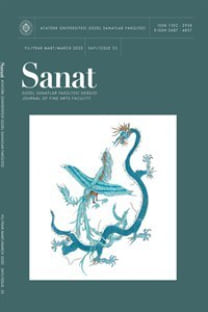SANAT EĞİTİMİNDE FELDMAN'IN SANAT ELEŞTİRİSİ YÖNTEMİNE DAYALI ÖNERİLEN BİR PROGRAMIN ETKİSİ
Bu çalışmanın amacı, Feldman'ın Sanat Eleştirisi Yöntemi'ne dayanan önerilen bir eğitim programının, çalışma örneğinin eleştirel performansını geliştirme üzerindeki etkisini araştırmaktır. Araştırmacı, araştırmanın amacına ulaşmak için, numunenin kritik performansını ölçen dört boyuta (Açıklama, Biçimsel Analiz, Yorumlama ve Yargı) dağıtılmış (14) maddeden oluşan görsel bir test geliştirdi. Araştırmanın örneklemini, 2019-2020 eğitim-öğretim yılının ilk yarıyılında Dahyat Prens Hassan Erkek İlköğretim Okulu'ndan uygun örnekleme yöntemiyle seçilen (70) öğrenci oluşturdu. Araştırma örneklemi rastgele iki gruba ayrıldı; 33 öğrenciden oluşan deney grubu ve (37) öğrenciden oluşan kontrol grubu. Çalışma sonuçları, deney grubu üyeleri lehine iki çalışma grubunun performansı arasında toplam ve bireysel test boyutlarında (Açıklama, Biçimsel Analiz, Yorumlama ve yargı) istatistiksel olarak anlamlı farklılıklar ortaya koymuştur. Çalışma, önerilen bu eğitim programının öğrencinin kritik performansını geliştirmede uygulanmasını önermektedir.
Anahtar Kelimeler:
eğitim programı, Feldman'ın eleştirel yöntemi, Kritik performans
THE EFFECT OF A PROPOSED PROGRAM BASED ON FELDMAN'S METHOD OF ART CRITICISM IN ART EDUCATION
The aim of the current study is to investigate the effect of a proposed educational program based on Feldman's Method of Art Criticism on developing the study sample’s critical performance. To achieve the purpose of the study, the researcher developed a visual test of (14) items distributed on four dimensions (Description, Formal Analysis, Interpretation and Judgment) measuring the sample’s critical performance. The study sample consisted of (70) students, selected using convenient sampling method from Dahyat Prince Hassan Elementary School for Boys in the first semester of 2019-2020 academic year. The sample of the study were divided into two groups selected randomly; The experimental group, consisting of (33) students; And the control group, consisting of (37) students. The results of study revealed a statistically significant differences in the total and individual test dimensions (Description, Formal Analysis, Interpretation and judgment) between the performance of the two study groups, in favor of experimental group members. The study recommends the application of this proposed educational program in developing student’s critical performance.
___
- Reference1 Belcoure, J. (2010). Viewing and Talking About Art:. Spring.
- Reference2 Blackmon, T. (2015). The Nature and Importance of Art Criticism and Its Educational Applications for k-12 Teachers". Florida: University of Central Florida Orlando.
- Reference3 Carney, J. D. (1994). A Historical Theory of Art Criticism. The Journal of Aesthetic Education, 28(1), 13-29.
- Reference4 Cromer, J. (1990). History, Theory, and Practice of Art Criticism in Art Education . USA: Natl Art Education Assn.
- Reference5 Emery, L. (2002). Teaching Art in a Postmodern World: Theories, Teacher Reflections and Interpretive Frameworks. Common Ground.
- Reference6 Feldman, E. (1994). Practical art criticism. USA: Englewood Cliffs, NJ: Prentice Hall.
- Reference 7 Gladston, P. (2015). Deconstructing Contemporary Chinese Art: Selected Critical Writings and Conversations, 2007-2014. Berlin: Springer.
- Reference8 Haddad, Z. (1993). Research in Art Criticism. Lebanon: Dar Al-Manhal.
- Reference 9 Hamblen, K. A. (1987 Published online: 28 Dec 2015). Hamplen (1986) mentions about a group of researchers some social benefits of studying criticism and artistic appreciation within art education. The most prominent of these benefits are: In an aesthetically-open audience in light of cognitive development,. Studies in Art Education, 28(2), 68-78.
- Reference 10 Hedayat, M. (2014). Conceptualizing Art Criticism and Art Education for Effective Practice. Saarbrücken: Lap lambert academic.
- Reference 11 Messersmith, R. (2018). The Effects of Feldman’s Art Criticism Model On the Sophistication of Writing in the Visual Arts. Kansas: University of Kansas .
- Reference 12 SEC3AEP, N. (n.d.). Writing about art. Retrieved 9 1, 2020, from https://sites.google.com/site/nyghsec3aep/writing-about-art
- Reference13 Smith, R. A. (1991). Aesthetics and Arts Education. Illinois: University of Illinois Press.
- Reference14 Wulf, C. (2014). Bilder des Menschen Imaginäre und performative Grundlagen der Kultur.Bielefeld: transcript verlag.
- Reference1 5 Wulf, C. a. (2007). Concepts of Aesthetic Education. Münster: Waxmann Verlag.
- Reference16 Ziad, H. (1993). Research in Art Criticism. Lebanon: Dar Al-Manhal.
- ISSN: 1302-2938
- Başlangıç: 2020
- Yayıncı: Atatürk Üniversitesi
Sayıdaki Diğer Makaleler
OSMANLI DÖNEMİ İNSAN FİGÜRLÜ ÇİNİ TASVİRLERİNDE BAŞ SÜSLEMELERİ
Eda DEMİR TOSUNOĞLU, Olcay BORATAV
ŞEMSE İKONOGRAFİSİ İÇİN BİR ÖNERİ
SANAT EĞİTİMİNDE FELDMAN'IN SANAT ELEŞTİRİSİ YÖNTEMİNE DAYALI ÖNERİLEN BİR PROGRAMIN ETKİSİ
Mowafaq ALSAGGAR, Taiesir TUBAISHAT
GOYA’NIN KARA RESİMLERİ VE "KÖPEK" ADLI RESMİNİN ANALİZİ
CARLO GOZZİ: COMMEDİA DELL’ARTE’Yİ HAYATTA TUTMAYA ÇALIŞAN ROMANTİK
Aligholi MARDANİ, Ashkan RAHMANI
Alper SAĞLIK, Merve TEMİZ, Gizem KASNİÇ, Abdullah KELKİT
DORNBURG ATÖLYESİNDEN TATBİKİ’YE SERAMİK
KARANTİNADA KLASİK CANLANIŞ: SOPHOCLES’İN ANTIGONE’SİNE ANTIGONENOW İLE HIBRİT BİR YANIT
HİMMET GÜMRAH’IN “SOMA İÇİN” ADLI RESMİNİN SANATSAL AÇIDAN İNCELENMESİ
